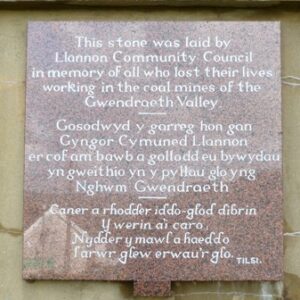The Town of Tumble is situated in the heart of the Gwendraeth Valley. The valley was an industrial hotspot during the outbreak of the Great War, and because of this, many men from outside the area worked and lived here. Below we remember these men of Tumble who gave their lives in that immense conflict, and the Second World War which followed. The War Memorials for the town are set on a wall in the War Memorial Garden, in Upper Tumble. This wall contains a plaque for the fallen of the Great War, another plaque for the fallen of World War Two, one to commemorate the men of the Gwendraeth Valley who have died in mining accidents, and a further plaque which commemorates Sergeant Michael James Winkler of the Royal Signals, who was killed in Northern Ireland.
The Great War, 1914-1918
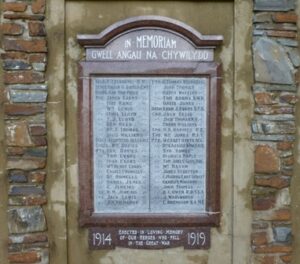
Thomas George Adams, Private, 27565, South Wales Borderers. Thomas was the son of Henry and Mary Adams, of Pembroke Dock. He worked as a journeyman baker prior to the war, and by 1911 was living in Gowerton. Thomas married Sarah Bowen at the end of 1914, and the couple resided at 79, High Street, Tumble. He enlisted at Haverfordwest into the Army, and was posted to the 11th Battalion, South Wales Borderers, which was attached to 115 Brigade, 38th (Welsh) Division. The Division had landed in France during December 1915 and had spent their first winter in the trenches near Armentieres. In June they marched south to the Somme, where they were tasked with the capture of Mametz Wood. The attack on the wood began on 7 July, but met with fierce resistance, and it took until 14 July to totally clear the wood. The Division suffered terrible casualties at Mametz, and were taken out of the line, and moved to Ypres to rebuild. Thomas was wounded at Ypres, and died of his wounds on 4 June 1917. He was 26 years old, and is buried in Mendinghem Military Cemetery, Belgium.
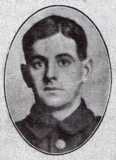
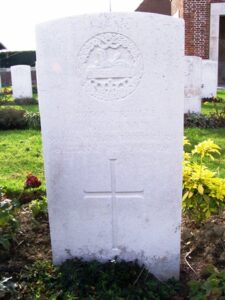
Christmas Evans Brunsdon, Private, 26977, Welsh Regiment. Christmas was born at Pontypridd in 1895, the son of Henry and Rosina Brunsdon. By 1911 the family was residing at 48, Railway Terrace, Tumble, where Christmas worked as a miner, along with his father Henry and elder brother, William. Christmas enlisted at Tumble into the Army, and was posted to the 8th Battalion (Pioneers), Welsh Regiment, which was attached to 40 Brigade, 13th (Western) Division. Christmas died on 12 May 1915, while the Division was assembling at Blackdown in Hampshire, in preparation for a move to Gallipoli. He was brought home for burial at Llannon (St. Non) Churchyard.
William James Casey, Private, 33166, Hampshire Regiment. William was the son of Dennis and Elizabeth Casey, of Swansea, and the Grandson of John William Parsons, of 2, St. Peter Street, Carmarthen. He married Agnes Jones, of Tumble in the summer of 1913, and the couple set up home in the village. William enlisted at Carmarthen into the Pembroke Yeomanry. He was then posted to the 1st Battalion, Hampshire Regiment, which was in France as part of 11 Brigade, 4th Division. The Division had been in France since the Battle of Le Cateau, and had then fought at Messines in 1914, Ypres in 1915, and on the Somme in 1916. In 1917 it took part in the Battle of Arras, and fought at Passchendaele later that year. In spring, 1918 the Division fought at the First Battle of Arras, and were then moved back to Flanders, where they took part in the Battle of Hazebrouck, where they played a part in the Defence of Hinges Ridge. They then fought at the Battle of Bethune, and during the Advance in Flanders, before moving south and fighting at the Battle of the Scarpe, the Battle of Drocourt-Queant, the Battle of the Canal du Nord, the Battle of the Selle and the Battle of Valenciennes. William was killed during the final fighting of the war, on 24 October 1918, aged 26. He is buried at Monchaux Communal Cemetery, France.
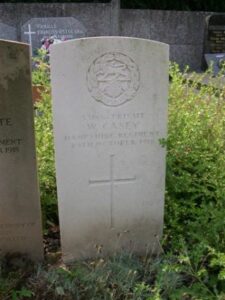
David Cassidy, Private, 9912, Manchester Regiment. David was born at Openshaw, Manchester in 1866. He enlisted at Ashton-Under-Lyne on 25 April 1904 into the 2nd Battalion, Manchester Regiment, and served in India before returning to Britain with his battalion in 1912, joining the army reserve on 19 April 1912. On 26 October 1912 he married Jane Lewis, a widow, of Virginia Cottages, Llannon, and David took up work as a plasterer. At the outbreak of the war David was mobilised, and joined his battalion in Ireland, where it was stationed at The Curragh, attached to 14 Brigade, 5th Division. On 17 August 1914 the division landed at Havre, and fought at the Battle of Mons, and during the retreat south, fighting at Le Cateau, then down to the Marne where the German attack was halted. They took part in the advance to the Aisne, before moving to Flanders, where they fought at the Battle of La Bassée, then at Messines in October 1914. David was reported as missing in action, presumed killed on 20 October 1914. He was 48 years old, and is commemorated on the Le Touret Memorial, Richebourg L’Avoue, France.
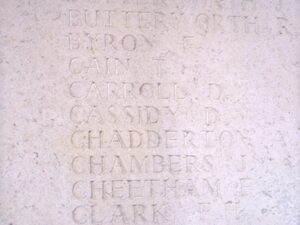
Benjamin Davies, Private, 13095, Welsh Regiment. Benjamin was born at Porth, the son of David and Esther Davies. The family had moved to 4, Thomas Terrace, Pwll prior to the war. Benjamin resided at Llandefeilog, probably working as a stationary engine driver at Tumble. He enlisted at Carmarthen into the Welsh Regiment, and was posted to France on 11 March 1915, joining the 2nd Battalion, Welsh Regiment, which was attached to 3 Brigade, 1st Division. The battalion was in trenches at Neuve Chapelle, near Bethune in Northern France. Benjamin saw his first major action during the Battle of Aubers Ridge on 9 May 1915, where the 2nd Welsh suffered heavy casualties. The battalion then went into reserve, to rebuild, before moving back into the front near Cuinchy on 20 May 1915. The sector was notoriously dangerous, and on 25 May 1915 Benjamin was listed as missing presumed dead after the battalion positions were shelled by the Germans. Benjamin was 21 years old, and is commemorated on the Le Touret Memorial, Richebourg L’Avoue, France. His brother Thomas was killed with the 8th Welsh at Gallipoli on 8 August 1915.
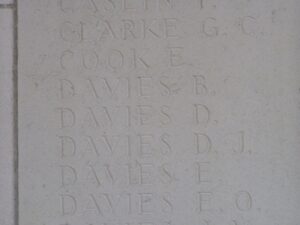
Enoch Oliver Davies, Lance Sergeant, 19042, Royal Welsh Fusiliers. Enoch was the son of Mr. and Mrs. John Davies, of Maesyffin, Horeb, Llandyssul, Cardiganshire. He was on the staff of Tumble Council School prior to the war, and lived there with his sister at Green Hill, Tumble. Enoch enlisted at Llanelli at the outbreak of war into the 16th Battalion, Royal Welsh Fusiliers. The battalion became part of 113 Brigade, 38th (Welsh) Division in the summer of 1915, and moved to France in December that year, taking up the line near Fleurbaix. In June 1916 the 38th Division made the long march south to the Somme, where it was tasked with the capture of Mametz Wood. Enoch was killed during the final assault on the wood on 11 July 1916. He was 20 years old, and is commemorated on the Thiepval Memorial, France.
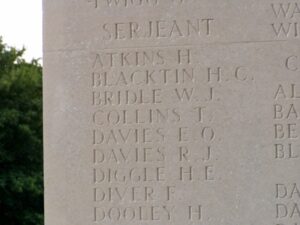
William Davies, Corporal, 40012, South Wales Borderers. William was born at Llangathen, probably the son of Thomas and Mary Anne Davies. William and his father worked as coalminers at Tumble prior to the war. He married Elizabeth Mary Rees of 24, Railway Terrace, Tumble prior to enlisting into the Royal Welsh Fusiliers, and landed in France on 19 December 1915. Early in 1916, William was transferred to the 2nd Battalion, South Wales Borderers, which had recently arrived back in England from duty at Gallipoli, as part of 87 Brigade, 29th Division. The Division took part in its first major action in France during the 1916 Somme Offensive, and fought at the Battles of Albert and Le Transloy, suffering heavy casualties. They remained on the Somme over the winter, and it was here that William was killed on 26 February 1917, aged 19. He has no known grave, and is commemorated on the Thiepval Memorial, France.
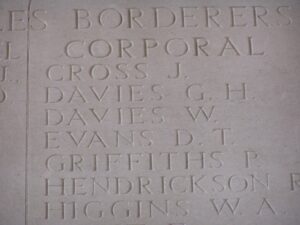
John Ellis, Private, 87219, Royal Field Artillery. John was born at Totnes, Devon, and resided at 35, Railway Terrace, Tumble prior to the war, working as a hewer at the local colliery. He enlisted there into the Royal Field Artillery, and was posted to their 64th Brigade, which was in France attached to the 12th (Eastern) Division. The Division landed at Boulogne on 31 May 1915, and took over the line at Ploegsteert Wood. They then moved south and fought in the Battle of Loos, and the subsequent actions of the Hohenzollern Redoubt, and remained there until March 1916. By June they were in position at the Somme, and attacked Ovillers on 2 July. They fought at Pozières and Le Transloy before being moved to the Arras area during October, 1916, where they fought in the March 1917 Battle of Arras. John was killed later in the year, on 3 September 1917, during the Battle of Passchendaele. He is buried at Potijze Chateau Grounds Cemetery, Belgium.
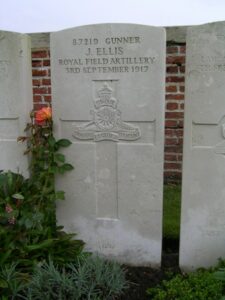
Daniel John Evans, Private, S/1708, Rifle Brigade. Daniel was born near Tumble on 18 June 1896, the son of Joshua and Hannah Evans. By 1901 the family had moved to 10, Baglan Street, Pentre, and Daniel enlisted at Merthyr Tydfil into the Rifle Brigade. He was posted to France on 21 July 1915 with the 11th Battalion, Rifle Brigade, which was attached to 59 Brigade, 20th (Light) Division. The Division moved to the Fleurbaix Sector for trench familiarisation and training, and launched a diversionary assault towards Fromelles during the Battle of Loos on 25 September 1915. Later that year they moved north, and fought at the Battle of Mount Sorrel alongside the Canadian Corps, before moving to the Somme in the summer of 1916. Daniel was wounded on the Somme, during the Battle of Guillemont, and died on 6 September 1916, aged 21. He is buried at La Neuville British Cemetery, Corbie, France. Daniel is not commemorated locally.
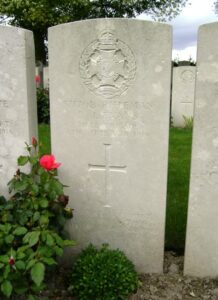
Evan James Evans, Bombardier, W/1445, Royal Field Artillery. Evan was the son of Thomas and Anne Evans, of Glan Towy, Bethesda Road, Tumble. He enlisted at Ammanford into the Royal Field Artillery, and was posted to the 122nd Brigade, which was attached to the 38th (Welsh) Division. The Division had formed in North Wales at the end of 1914, and had moved to France during December 1915, seeing action at Mametz Wood the following year. The division took part in the capture of Pilckem Ridge at Third Ypres in 1917. They then moved to Armentieres, where they remained from September 1917 until March 1918 when the German Spring Offensive was launched. The British had been over-run on the Somme, and so in April the Division was moved South, taking up positions North of Albert. On 21 August 1918 the 38th Welsh Division crossed the River Ancre, and captured Thiepval and Pozières Ridge, before moving east towards Bapaume. Then the move began towards the mighty Hindenburg Line, and the Division carried on with their march east, fighting at the Battle of Havrincourt, and the Battle of Epehy. A short rest period ensued, during which time the Canal du Nord was breached, so opening a passage through the Hindenburg Line. The Division then fought at the Battle of Beaurevoir, and moved up towards Cambrai, capturing Villers-Outréaux, before advancing to the Selle and onto the Sambre. Evan was taken ill during the great advance, and was evacuated to the base hospital at Rouen for treatment. He died of pneumonia there on 30 October 1918, aged 27, and is buried in St. Sever Cemetery Extension, Rouen, France.
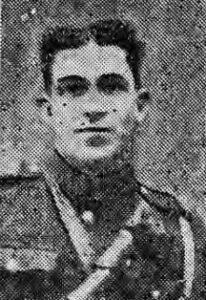
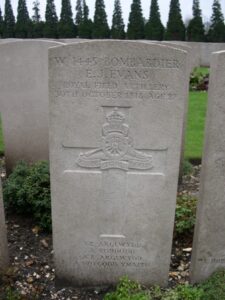
James Evans, Private, 12150, Royal Welsh Fusiliers. James was born at Llangynog. He enlisted at Tumble into the 8th Battalion, Royal Welsh Fusiliers. The battalion had formed at Wrexham, becoming attached to 40 Brigade, 13th (Western) Division. Between 6 and 16 July 1915 the Divisional infantry landed on Cape Helles and relieved the 29th Division. They left and returned to Mudros at the end of the month, and the entire Division landed at ANZAC Cove between 3 and 5 August 1915, taking part in the Battle of Sari Bair. James was killed here on 16 August 1915. He has no known grave, and is commemorated on the Helles Memorial, Gallipoli.
John Garfield Evans, Lance Corporal, 13009, Royal Welsh Fusiliers. John was the son of John and Mary Evans, of Tymawr, Cellan, Lampeter. He was working at Tumble prior to the war, and enlisted there into the 10th Battalion, Royal Welsh Fusiliers, which had formed at Wrexham on 16 September 1914, joining 76 Brigade, 25th Division at Codford St. Mary, Salisbury Plain. On 27 September 1915 the Division landed at Boulogne, and the following month 76 Brigade moved to 3rd Division, which was at St. Eloi. The Division moved to the Somme in the summer of 1916, and took part in the great offensive there. John was killed during the Battle of Delville Wood on 20 July 1916. He was 22 years old, and is commemorated on the Thiepval Memorial, France. John is not commemorated on the Tumble War Memorial.
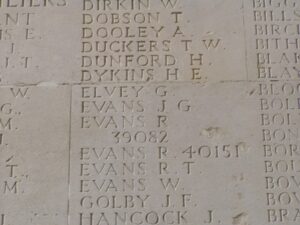
Thomas Evans, Private, 782, Welsh Regiment. Thomas was the son of Griffith and Margaret Evans, of Brynynyd, Tumble. He enlisted at Carmarthen into the local Territorial unit, the 4th Battalion (Carmarthen), Welsh Regiment. In April 1915 the battalion joined 159 Brigade, 53rd (Welsh) Division, and moved to the Mediterranean, sailing from Devonport in July, 1915 arriving at Mudros by 5 August 1915. From here they moved to Gallipoli, landing on 9 August. Here the Division was immediately thrown into action, and spent the next few days in isolated pockets, fighting against a Turkish counter-attack during the Battle of Sari Bair, and then at the Attack on Scimitar Hill. Thomas was wounded six weeks after landing. He was evacuated to Malta for treatment, but died of his wounds on 27 September 1915. He was 20 years old, and is buried at Pieta Military Cemetery, Malta.
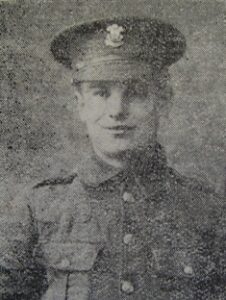
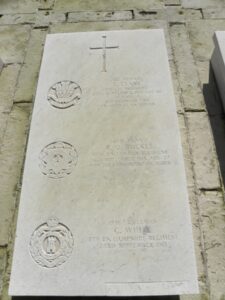
William Henry Evans, Private, 61652, Welsh Regiment. William was the son of Mrs Theodosia Evans, of Plaindealings, Llanddewi Velfrey, Pembrokeshire. He worked at Bronwydd House, Tumble as a baker prior to the war, and enlisted at Llanelli into the Army Service Corps. William was posted to the 40th Field bakery at Mudros on 27 October 1915. He served in the Mediterranean until January 1918 when he was transferred to the infantry, and was posted to the 24th Battalion, Welsh Regiment. The battalion had been formed in Egypt during February 1917, from two dismounted Regiments; the Pembrokeshire Yeomanry and the Glamorganshire Yeomanry. They formed part of 231 Brigade, 74th Yeomanry Division, which was sent to France in May 1918, landing at Marseilles on 7 May 1918. The Division was fighting in the Battle of Epehy in September 1918, and the 24th Welsh were tasked with the capture of the German stronghold of Gillemont Farm. The Farm formed part of the Outpost Defences of the Hindenburg Line, and the Welsh suffered terrible casualties here. One of them being William, who was killed in action, aged just 21, on 21 September 1918. His body was lost on the battlefield, and so William is remembered on the Vis-en-Artois Memorial, France.
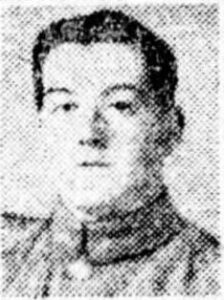
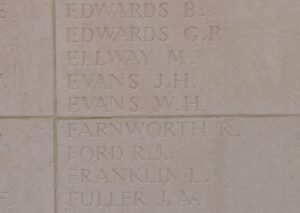
William Ivor Evans, Private, 3941, Welsh Regiment. William was the son of Maurice and Anne Evans. The family was originally from Windmill Farm, Laugharne, but had moved to 64, High Street, Tumble prior to 1911. William enlisted at Tumble into the 1/4th Battalion (Carmarthen), Welsh Regiment, which was the local territorial battalion, attached to 159 Brigade, 53rd (Welsh) Division. The division landed at Gallipoli on 8 August 1915, and was plunged head first into terrible fighting. William was killed on his second day on Gallipoli, on 10 August 1915, during the Battle of Sari Bair (Attack on Scimitar Hill). He was 24 years old, and is commemorated on the Helles Memorial, Gallipoli.
John Griffiths, Sergeant, 13126, Welsh Regiment. John was born at Llanpumsaint, and enlisted at Tumble into the 9th Battalion, Welsh Regiment. The battalion had been in France since July 1915, as part of 58 Brigade, 19th (Western) Division, and had fought at Loos later that year, and on the Somme in 1916. During 1917 the division fought at Messines and Passchendaele, before moving to the southern sector of the Somme for the winter. In 1918 they were caught up in the German Spring Offensive near St. Quentin, where they suffered terrible casualties, and fought at the Battle of Bapaume. They moved to Ypres, but were caught up in the German attack at Messines, and at Bailleul, and Kemmel. After suffering terribly again, they moved south to the quieter French sector to rebuild, but were caught up in the German offensive on the Aisne, and fought during the Battle of the Selle, Valenciennes, the Sambre and the Passage of the Grand Honelle. John was killed during the last few days fighting before the armistice, on 4 November 1918. He is buried at Cross Roads Cemetery, Fontaine-Au-Bois, France.
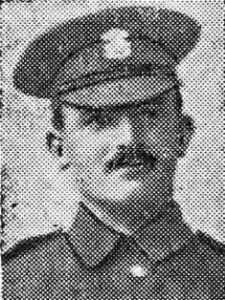
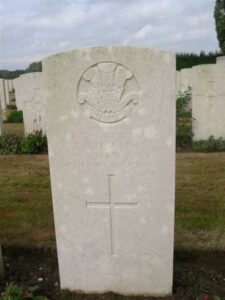
William Henry Harries, Sapper, 45944, Royal Engineers. William was born at Neath in 1890, the son of David and Margaret Harries. He married Lizzie A Morgan early in 1912, and the couple set up home at Aubrey House, Bethesda Road, Tumble, where their son Frederick Lewis Harries was born on 16 November 1912. William worked at Llanelli in the Locomotive and Carriage Department of the Great Western Railway, and enlisted at Tumble into the Royal Engineers. William landed in France on 11 September 1915, and served with the 97th Field Company, Royal Engineers, which was attached to the 21st Division. He saw service at Loos that month, on the Somme in 1917, then at Passchendaele in 1917. At some time William became ill, and was evacuated to Britain for treatment. Sadly he died on 16 January 1918, aged 27, and is buried at Tumble (Bethania) Congregational Chapelyard.
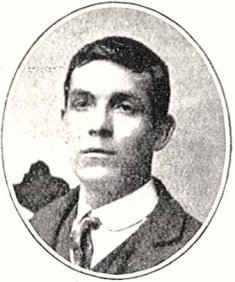
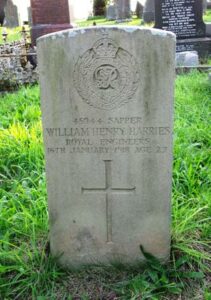
Sydney George Hawke, Private, R/25220, Kings Royal Rifle Corps. Sydney was the Husband of Emily Louisa Hawke, of 341, Grosvenor Buildings, Poplar, London. He worked in the mines at Tumble prior to the war, lodging at 4, Church Place, Tumble, and returned to London to enlist at Canning Town into the 11th Battalion, King’s Royal Rifle Corps, which was attached to 59 Brigade, 20th (Light) Division. On 26 July 1915 the Division completed concentration in the Saint-Omer area, and moved to the Fleurbaix Sector for trench familiarisation and training. When the Battle of Loos was launched on 25 September 1915 the Division fought a diversionary attack towards Fromelles. Later that year they moved north, and fought at the Battle of Mount Sorrel alongside the Canadian Corps. They then fought through the Somme Offensive, and took part in the advance to the Hindenburg Line in March, 1917. Later that year they fought at Third Ypres, before moving south in November, to take part in the Battle of Cambrai. They remained in the area between Cambrai and St. Quentin over the winter of 1917/18 and were attacked there by the German Spring Offensive of 21 March, 1918. They then fought in the retreat at the Battle of the Somme Crossings and the Battle of Rosieres. Sydney died on 17 April 1918, aged 29, and is buried at Foreste Communal Cemetery, France.
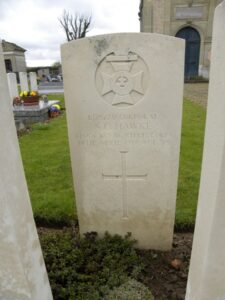
Charles Morris Howells, Private, 3991, Welsh Regiment. Charles was the son of Edward and Elizabeth Howells, of 4, Williams Terrace, Llanfair, Anglesey. He worked at Tumble prior to the war, and enlisted there into the 1/4th Battalion (Carmarthen), Welsh Regiment, which was attached to 159 Brigade, 53rd (Welsh) Division. The 53rd (Welsh) Division moved to the Mediterranean, sailing from Devonport in July, 1915 arriving at Mudros by 5 August 1915. From here they moved to Gallipoli, landing on 9 August. Here the Division was immediately thrown into action, and spent the next few days in isolated pockets, fighting against a Turkish counter-attack during the Battle of Sari Bair, and then at the Attack on Scimitar Hill. Charles was taken ill, and evacuated to Hospital in Egypt, but died there on 1 October 1915. He was 22 years old, and is buried at Cairo War Memorial Cemetery, Egypt.
David Howells, Private, 20188, Welsh Regiment. David was born at Llangyfelach in 1888, the son of George Howells and Mary Howells (nee Rees). The family then moved to 3, Brook Terrace, Gwaun-cae-Gurwen. David married Caroline Griffiths, a single mother, in the summer of 1913 and the couple moved to 80, High Street, Tumble, where David worked as a collier. He enlisted at Llanelli into the 15th Battalion, Welsh Regiment, during a recruitment drive soon after the outbreak of war. The battalion, known as the Carmarthen Pals battalion, was attached to 114 Brigade, 38th (Welsh) Division. On 2 December 1915 the battalion moved to France, and the entire Division moved to the Fleurbaix sector, where it was initiated into trench warfare. On 9 March 1916 the Battalion was holding the line at Gorre when the Germans exploded a mine under their forward positions, killing seven men, including David. The 27-year-old is buried in Guards Cemetery, Windy Corner, Cuinchy, France.
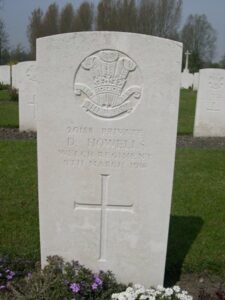
William John Huxtable, Private, 203323, Welsh Regiment. William was born at Loughor in 1885. He resided at 26, The Row, Tumble for most of his life, with his adoptive parents John and Margaret Charles. William enlisted at Llanelli into the 1/4th Battalion, Welsh Regiment, which was the local Territorial Battalion, attached to 159 Brigade, 53rd (Welsh) Division. William does not seem to have served overseas with the battalion, but sadly killed himself while suffering from depression at Hearston Camp, Pembrokeshire on 15 August 1917, aged 32. William is buried at Llannon (St. Non) Churchyard. William is not commemorated on the Tumble War Memorial.
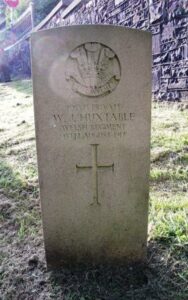
Daniel James, Private, 200168, Welsh Regiment. Daniel was born on 7 February 1888, the son of Thomas and Mary James, of Lan Farm, Pencader. He worked as a coalminer at Tumble prior to enlisting at Carmarthen into the 1/4th Battalion, Welsh Regiment. The Battalion was attached to 159 Brigade, 53rd (Welsh) Division, and in July 1915 sailed from Devonport for Egypt. On 9 August 1915 the Division had moved from Egypt, and landed on Gallipoli. They fought on Gallipoli until evacuation in December, 1915, after suffering terrible casualties, and moved to positions on the Suez Canal. In early 1917 the British launched an attack into Palestine, which was occupied by the Turks, and Daniel was killed in action here at the First Battle of Gaza, on 21 April 1917, aged 29. He was originally buried in Sampson’s Ridge, No. 1 Cemetery, but his grave was re-interred after the war and he now lies in Gaza War Cemetery.
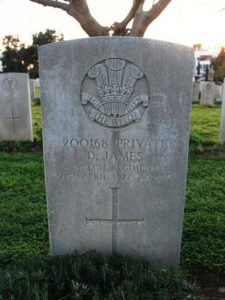
Charles Jenkins, Private, 4173, Welsh Regiment. Charles was the son of Sydney and Mary Ann Jenkins, of The Institution, Eastville, Bristol. He had worked as a farm servant at Carmarthen before moving to Tumble prior to the war to work as a miner, and enlisted there into the 1/4th Battalion (Carmarthen), Welsh Regiment, which was attached to 159 Brigade, 53rd (Welsh) Division. The Division moved to the Mediterranean, sailing from Devonport in July, 1915 arriving at Mudros by 5 August 1915. From here they moved to Gallipoli, landing on 9 August. Here the Division was immediately thrown into action, and spent the next few days in isolated pockets, fighting against a Turkish counter-attack during the Battle of Sari Bair. Charles was killed soon after, on 10 August 1915. He was 22 years old and is commemorated on the Helles Memorial, Gallipoli.
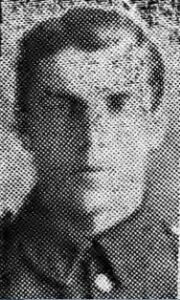
Daniel Morleigh Jenkins, Private, 851, Welsh Regiment. Daniel was born on 31 August 1896, the son of David and Rachel Jenkins, of Milford House, New Quay. He worked at Tumble prior to the war, and enlisted at Carmarthen on 12 January 1915 into the 1/4th Battalion, Welsh Regiment, which was the local Territorial Battalion, attached to 159 Brigade, 53rd (Welsh) Division. The Division landed at Cape Helles, Gallipoli, on 9 August 1915, and was immediately thrown into action, spending the next few days in isolated pockets, fighting against a Turkish counter-attack during the Battle of Sari Bair, and then at the Attack on Scimitar Hill. Daniel was wounded soon after the battalion landed on Gallipoli, whilst attempting to fetch some water for himself and some friends. He was evacuated aboard a Hospital Ship, but died at sea on the way to Alexandria on 16 August 1915. Daniel was 18 years old, and is commemorated on the Helles Memorial, Gallipoli.
David Jones, Private, 14124, Royal Welsh Fusiliers. David was the son of E. Jones of Tumble, and enlisted at Tumble into the army. He was then posted to the 11th Battalion, Royal Welsh Fusiliers, which was attached to 67 Brigade, 22nd Division. The Division crossed to France in early September 1915, but it’s stay in France was to be very short, as on 27 October 1915 the Division began to embark for Salonika. It completed concentration there in November, and remained in the theatre for the rest of the war. After taking part in several battles over the coming years, on 18 September 1918 the division fought at the Second Battle of Doiran. David was killed in action that day. He was 27 years old, and is commemorated on the Doiran Memorial, Greece. David is not named on the Tumble War Memorial.
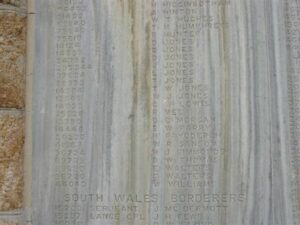
David Gravelle Jones, Private, 10643, South Wales Borderers. David was the son of John Jones, Glyndwr House, Upper Tumble. He was a regular soldier, after having enlisted at Swansea into the 2nd Battalion, South Wales Borderers. The battalion returned from China early in 1915 to join 87 Brigade, 29th Division. The Division moved to Gallipoli via Egypt, landing on 25 April, 1915. They remained here until evacuation to Egypt on 11 January, 1916 and then moved to the Western Front on 15 March 1915. The Division took part in its first major action in France during the 1916 Somme Offensive, and fought at the Battles of Albert and Le Transloy, suffering heavy casualties. David was killed on the Somme on 25 September 1916, aged 25. For some strange reason, he is commemorated on the Ypres (Menin Gate) Memorial, Belgium, which is the wrong memorial for the battle in which he fell.
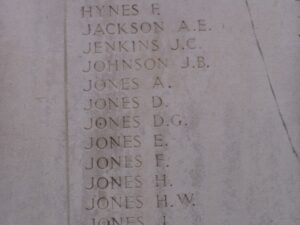
Tom Jones, Private, 36960, Gloucestershire Regiment. Tom was born in 1897, the son of David and Mary Letitia Jones, of Tymble Hotel, Llannon. The family later resided at Morawel, Tumble. Tom originally served in the 4th (Reserve) Battalion of the Welsh Regiment, number 5471. At some time in 1916 he was moved to France where he joined the 10th Battalion, Gloucestershire Regiment being renumbered to 36960. On 14 February 1918 the battalion was disbanded and Tom became attached to the 13th Entrenching Battalion for a short while before becoming posted to the 5th Battalion, Oxford and Buckinghamshire Light Infantry. The battalion was attached to 42 Brigade, 14th (Light) Division and was in positions south of St Quentin, on a ridge overlooking the River Oise. The division was hit hard by the Germans following the launching of their offensive of 21 March 1918 and took part in heavy fighting over the coming days. Tom was wounded at some time afterwards and died of his wounds on 8 April 1918, aged 21. He was originally buried amongst German dead at Cappy French Military Cemetery, but after the war the British graves were concentrated at Fouquescourt British Cemetery, France, and Tom is interred in plot 1, row K grave 3, his headstone having the inscription chosen by his father ‘His sun is gone down while it was yet day.’
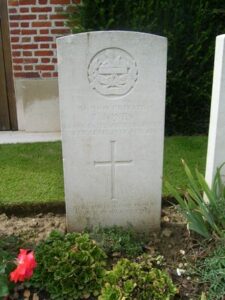
William Jones, Trumpeter, Pembroke Yeomanry. William cannot presently be identified.
Tom Kane, Private, 37771, Welsh Regiment. Tom was born at Llangoedmor in 1881, the son of Elizabeth Kane. He resided at Penffin, Blaenporth prior to the war, with his wife Ann, and had probably worked in the colliery at Tumble. He enlisted at Cardiff into the 8th Battalion, Welsh Regiment, which was attached to 40 Brigade, 13th (Western) Division. In January 1915 the battalion became the Pioneer Battalion to the Division, and on 15 June 1915 sailed from Avonmouth for Mudros, preparatory to landing at Anzac, Gallipoli on 5 August 1915. Ton joined the battalion at Gallipoli on 10 October, and was on the Peninsula during the terrible winter of 1915. On 8 January 1916, the Division was evacuated from Helles, and by 31 January was concentrated at Port Said, where they held forward posts in the Suez Canal defences. On 12 February 1916 the Division began to move to Mesopotamia, and took part in a hard campaign against the Turks. Tom was wounded during the drive into Mesopotamia, and died there on 9 March 1917, aged 35. He has no known grave, and is commemorated on the Basra Memorial, Iraq.
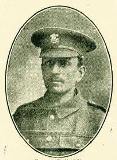
John James Lewis, Private, 200798, Welsh Regiment. John was the Husband of Jane Eleanor Lewis, of 67, Charles St., Jarrow, Co. Durham. He resided at Tumble prior to the war, and enlisted there into the 1/4th Battalion (Carmarthen), Welsh Regiment, which was attached to 159 Brigade, 53rd (Welsh) Division. John probably landed at Gallipoli with the battalion on 8 August 1915, and fought there until they were evacuated in December 1915. They remained on the Suez Canal Defences for the next twelve months, and in early 1917 moved into Palestine, where they remained for the duration of the war, fighting at the Battles of Gaza, and successfully capturing Jerusalem. John was killed during the First Battle of Gaza on 26 March 1917. He was 42 years old, and is commemorated on the Jerusalem Memorial, Israel.
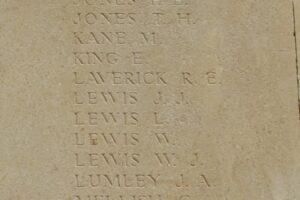
William David Lewis, Private, 6353, Royal Welsh Fusiliers. William was born at St. Peters, Carmarthen, the son of Eliza Lewis. He had served in the Carmarthen RGA prior to the war, and was a miner, the Husband of Anne Jane Lewis, of 4, Church Place, Tumble. He enlisted at Llanelli in October 1914 into the Royal Welsh Fusiliers. William’s service papers survive, but are in poor condition, and they show that he landed in France on 25 May 1915, then deserted at some time, before being posted to the 10th RWF, being wounded with them at Ypres in 1917. On his recovery he joined the 13th Battalion, Royal Welsh Fusiliers, which was attached to 113 Brigade, 38th (Welsh) Division. He probably rejoined them before the division moved to the Somme in March 1918. They had been sent there to consolidate the line around Aveluy Wood, north of Albert, after the German Spring Offensive has pushed the British back during the preceding weeks. Soon after taking the line on the Somme, 113 Brigade was tasked with straightening the line in front of Bouzincourt, on the southern side of Aveluy Wood, and suffered heavy casualties while doing so. William was one of the men who died during the operation on 9 May 1918. He was 39 years old, and is buried at Bouzincourt Communal Cemetery Extension, France.
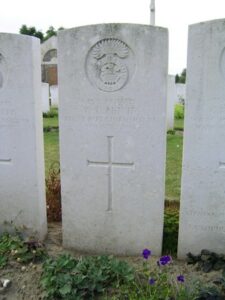
Ithiel Lloyd, Private, 229335, Monmouthshire Regiment. Ithiel was the son of Elizabeth Lloyd, Moclyn View, Lord Street, Blaenau Ffestiniog. He worked as a miner at Tumble prior to the war, and resided at 26, Railway Terrace, Tumble with his brother George, and sister Jane. Ithiel enlisted at Carmarthen into the South Wales Borderers during February 1917, after having served in the Royal Field Artillery. He was posted to the 11th South Wales Borderers on 21 June 1917, which was in France attached to 115 Brigade, 38th (Welsh) Division. Ithiel was wounded during the Battle of Langemarck, after being shot in the right hand, and upon recovering, was posted to the 10th Battalion, South Wales Borderers, in the same division. Ithiel was shot in the abdomen during the great advance on 28 August 1918, and was sent, via the normal route of casualty clearing stations, to Runcorn Hospital. He died of his wounds there on 12 November 1918, aged 30, and was brought home for burial at Penmachno (St. Iudclyd) Churchyard.
Thomas John Lloyd, Private, 31596, Royal Welsh Fusiliers. Thomas was the son of Richard and Margaret Lloyd, of 39, High Street, Tumble. He originally enlisted into the 12th Reserve Cavalry Regiment on 5 September 1914, before being transferred to the Royal Welsh Fusiliers, landing in France on 30 September 1915, and posted to the 1st Battalion, Royal Welsh Fusiliers, which was attached to 22 Brigade, 7th Division. The Division had been on the Western Front since October 1914, and had fought at Ypres and Loos over the coming eighteen months. In the summer of 1916, the Division were on the Somme, and took part in the Battle of Albert, where they captured Mametz, one of the few successes of 1 July 1916. They then fought at the Battle of Bazentin, and the Attacks on High Wood, playing a successful part in the ‘dawn attack’, and were also the first troops into High Wood. The Division then took part in the Battle of Delville Wood, and the Battle of Guillemont, before spending the winter on the Ancre. In March 1917 they followed up the German Retreat to the Hindenburg Line, and took part in Flanking Operations Round Bullecourt, where the division took part in heavy fighting alongside the Australians. Thomas was reported as being wounded and missing at Bullecourt on 3 May 1917. He was 29 years old. No trace of him was ever found, so Thomas was officially assumed to have been killed on that date, and is commemorated on the Arras Memorial, France.
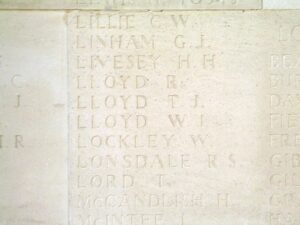
Cornelius Maguire, Private, 14014, Loyal North Lancashire Regiment. Cornelius (shown on the memorial as Charles) had been born at Blackburn, the son of James and Mary Maguire. He was an army reservist, and must have worked at Tumble prior to the war, before being mobilised, returning to Blackburn to join the 8th Battalion, Loyal North Lancashire Regiment, which was attached to 7 Brigade, 25th Division. The Division was formed during September 1914 and landed at Zeebrugge on 6 October 1914. The City was already falling however, and so the Division was moved to Ypres, where they became the first British Division to hold the city, and fought during the First Battle of Ypres, where they helped stop the German advance through Belgium. In March, 1915 the division fought at the Battle of Neuve Chapelle, and in May they fought at the Battle of Aubers Ridge, and at Festubert, before taking part in the Battle of Loos in September. Cornelius was killed on 12 December 1915. He is buried at London Rifle Brigade Cemetery, Belgium.
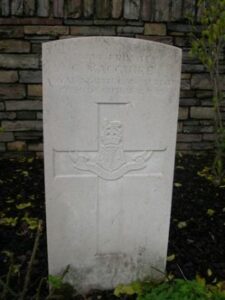
Reginald Maple, Private, R/18558, King’s Royal Rifle Corps. Reginald was born at Salisbury in 1894, the son of Thomas and Elizabeth Maple. His father died in 1899 and his mother had married Thomas Johnson before the family moved to 15, Bargoed Terrace, Ponthenri. Reginald married Ada Florence Kate Mager at Llanelli in 1914. The couple set up home at 10, Railway Place, Tumble, but soon afterwards Reginald appears to have deserted her. Reginald enlisted at Tumble into the 6th Battalion, East Lancashire Regiment on the outbreak of war, but was discharged on 16 October 1914 after being deemed unsuitable for military service. As casualties mounted on the Western Front, the standards were lowered, and many men were called to the colours who had been turned down in the early months of the war. Reginald then joined the 9th Battalion. King’s Royal Rifle Corps, which was attached to 42 Brigade, 14th (Light) Division. The Division was to see its first action during the Action of Hooge, where the Division were the first to be attacked by the German use of flamethrowers. They then fought at the Second attack on Bellewaarde. In July 1916 they moved to the Somme, and fought at the Battle of Delville Wood, and then the Battle of Flers-Courcelette, and in March, 1917 followed the German Retreat to the Hindenburg Line. May saw them at Arras, where they took part in the First Battle of the Scarpe, and later at the Third Battle of the Scarpe, and then they were sent to Ypres, where they fought at the Battle of Langemarck. Reginald was killed at Langemarck on 21 August 1917, aged 23. He is buried in Birr Cross Roads Cemetery, Belgium.
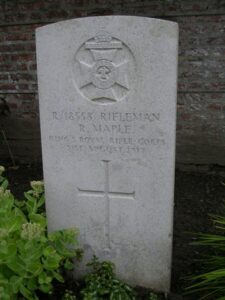
William Mason, Private, 17180, Leicestershire Regiment. William was the son of Tom and Elizabeth Ann Mason, of 66, Cranbourne Street, Belgrave, Leicester. He resided at 46, Railway Terrace, Tumble prior to the war, with his brother Thomas and his family, and enlisted at Llanelli into the army. On 25 May 1915 William was posted to France, joining the 2nd Battalion, Leicestershire Regiment, which was attached to Garhwal Brigade, 7th (Meerut) Division. William was killed during the Battle of Loos on 25 September 1915. He was 27 years old, and is commemorated on the Loos Memorial, France.
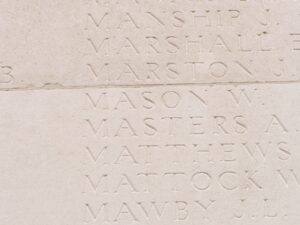
Charles Maurice, Private, East Surrey Regiment. This man cannot be traced, but the 1911 Census shows him as a Lodger at 16, King Street, Carmarthen, where he worked as a Hairdressers Manager. He was born at Baglan during 1890.
Grosby Owen, Private, 15052, Kings Shropshire Light Infantry. Grosby was born at 62, Water Street, Carmarthen in 1895, the son of Thomas and Hannah Owen. He resided at Tumble prior to the war, working as a miner at Pontyberem. He enlisted at Llanelli into the 2nd Battalion, King’s Shropshire Light Infantry, which was attached to 80 Brigade, 27th Division. The 27th Division was formed in England in October-November 1914, from regular units returning from India, Hong Kong and Canada. On 21 December 1914 it landed in France and proceeded to the Western Front, where it fought at the Action of St Eloi, and at The Second Battle of Ypres. Grosby was killed there on 25 May 1915, and is commemorated on Panel 49 of the Ypres (Menin Gate) Memorial, Belgium.
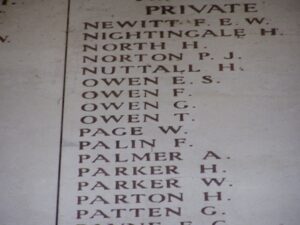
Dan Ivor Price, Private, 40048, Royal Welsh Fusiliers. Dan was born in 1896, the son of David Price and Margaret Elizabeth Price (nee Davies), of Peniel School House, Abergwili. His father was the Schoolmaster at Abergwili for several years prior to moving with the family to Chapel House, Peniel, following the death of his wife. Dan was educated at Carmarthen Grammar School, and moved to Tumble prior to the war, gaining work there as a school teacher. Dan left his job as a teacher at Tumble to enlist at Carmarthen into the 22nd Battalion, Royal Welsh Fusiliers on 10 December 1915, and was initially placed on the Army Reserve. He was mobilised on 21 January 1916, travelling to Conway to then join the battalion at Kinmel Park. On 28 July 1916 Dan was drafted to France and two days later was posted to the 1st Battalion, Royal Welsh Fusiliers, which was on the Somme, attached to 22 Brigade, 7th Division. The Division had taken part in the opening assault of the Somme offensive on 1 July 1916, advancing from positions near Bois Francais, near Fricourt, and capturing the village of Mametz, one of the few successes of 1 July 1916. The battalion then took part in further attacks to push forwards, to the south of Mametz Wood, and upon being relieved, witnessed the troops of the 38th (Welsh) Division moving forward to launch its assault on Mametz Wood. On 14 July, with the wood taken, the 7th Division moved back into the line, with orders to capture Bazentin-le-Petit, before taking part in the terrible attacks on High Wood over the coming days. On 22 July the 1st RWF was relieved, moving back into reserve to rest and rebuild at La Chaussee. By 12 August the battalion had moved forwards to Dernancourt, and on 26 August marched further forward, to take part in the Divisions assault on Ginchy. The Division saw heavy fighting over the coming days, before the 1st RWF had another short break, but on 1 September the battalion received orders to push forwards again to launch a fresh assault on Ginchy from Montauban Alley. On 3 September 1916 the 1st RWF launched its assault, but suffered severe casualties, with over 200 officers and men killed, wounded or missing. The division was then relieved and transferred north to the Ypres Salient to rest and rebuild, in positions near Ploegsteert Wood, but at the beginning of November was ordered to move south, back to the Somme Sector, where it wintered. On 25 February 1917 patrols discovered that the Germans had evacuated Serre, so the 1st RWF received orders to advance and seize the village of Puisieux. Dan was killed in action here on 26 February 1917, when the advancing troops became held up by intense German artillery fire. The 20-year-old has no known grave and is commemorated on the Thiepval Memorial, France.
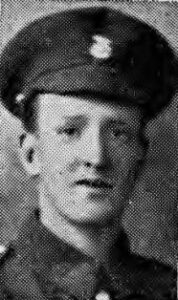
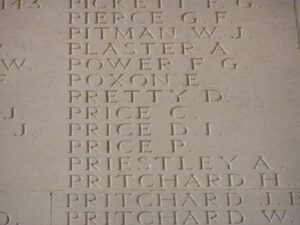
Benjamin Rees, Private, 13127, Welsh Regiment. Benjamin was born in 1883, the son of David and Hannah Rees, of Rhydhalen, Newcastle Emlyn. Benjamin had worked at Tumble for several years prior to the war, and enlisted there at the outbreak of war into the 2nd Battalion, Welsh Regiment, joining the battalion in France on 2 December 1914. The Battalion was attached to 3 Brigade, 1st Division, which was one of the first to arrive in France, fighting at the Battle of Mons, and taking part in the retreat to the Marne, where the Germans were stopped. They then fought at the Aisne, and at Chivy, before being moved North to Ypres. Here they fought at the First Battle of Ypres, where they again stopped the German Offensive, before wintering in Flanders. Benjamin was killed in action in Flanders, during the First Action of Givenchy, on 25 January 1915, aged 31. He has no known grave, and so is remembered on the Le Touret Memorial, Richebourg L’Avoue.
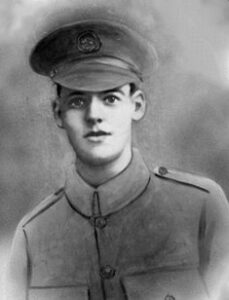
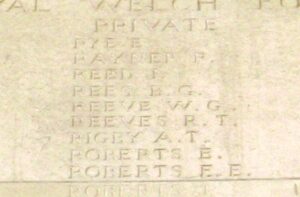
John Henry Richards, Private, 11833, Welsh Regiment. John was born at Felinfoel in 1888. He worked as a coal hewer at Tumble prior to the war, and enlisted there into the 8th Battalion (Pioneers), Welsh Regiment, which was attached to 40 Brigade, 13th (Western) Division. Towards the end of February the entire Division concentrated at Blackdown in Hampshire, and on 7 June 1915 orders were received to prepare to move to the Mediterranean. On 13 June 1915 the first transports carrying the Division left port, and moved to Alexandria. By 4 July, all units had moved to Mudros, preparatory for landing on Gallipoli. Between 6 and 16 July 1915 the Divisional infantry landed on Cape Helles and relieved the 29th Division. They left and returned to Mudros at the end of the month, and the entire Division landed at ANZAC Cove between 3 and 5 August, 1915, taking part in the Battles of Sari Bair, Russell’s Top, and Hill 60. John was killed during the Battle of Sari Bair on 8 August 1915, aged 27. He has no known grave, and is commemorated on the Helles Memorial, Gallipoli.
Thomas Slimm, Private, 8729, Worcestershire Regiment. Thomas was born in Dudley in 1886, the son of John and Nancy Slimm. He had worked as a carter prior to enlisting into the South Staffs at Lichfield on 8 March 1904 and had served in South Africa with the regiment before returning to England, and transferred to the Worcestershire Regiment in 1911. He married Rebecca Pritchard at Dudley on 1 February 1914 and the couple had a daughter, Thomasina. Thomas embarked for France with the 2nd Battalion, Worcestershire Regiment on 12 August 1914. The battalion was attached to 5 Brigade, 2nd Division, and took part in the Battle of Mons and the subsequent retreat to the Marne, fighting in the Battles of the Marne and Aisne. Thomas was killed on 14 September 1914, the day after crossing the Aisne. He has no known grave and is commemorated on the La Ferte-Sous-Jouarre Memorial, France. His widow Rebecca later re-married and lived at 27, Council Houses, Upper Tumble, by 1919. Thomas never lived at Tumble, so is not named on the war memorial.
Arthur James Stratton, Private, 25707, Royal Welsh Fusiliers. Arthur was the son of John and Rosina Stratton, of 2, Church Place, Tumble. He enlisted at Llanelli on 19 March 1915 into the 17th Battalion, Royal Welsh Fusiliers, which was attached to 115 Brigade, 38th (Welsh) Division. The Division had landed in France during December 1915 and had spent their first winter in the trenches near Armentieres. In June they marched south to the Somme, where they were tasked with the capture of Mametz Wood. The attack on the wood began on 7 July, but met with fierce resistance, and it took until 14 July to totally clear the wood. The Division suffered terrible casualties at Mametz, and were taken out of the line, and moved to Ypres to rebuild. Here they fought at the Battle of Pilckem Ridge, and the Battle of Langemarck. They then moved to Armentieres, where they remained from September 1917 until March, 1918 when the German Spring Offensive was launched. The British had been over-run on the Somme, and so in April the Division was moved south, taking up positions North of Albert. Arthur was killed here on 9 May 1918. He was 28 years old, and is buried at Bouzincourt Communal Cemetery Extension, France. After the war his parents retired to 1, Park View, Felinfoel, Llanelli.
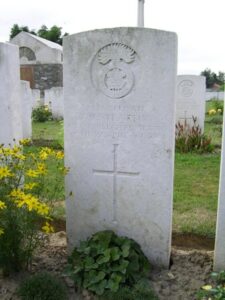
David James Thomas, Private, 12968, Royal Welsh Fusiliers. David was born at Rhosygilwen, Blaenporth in 1893, the son of James and Ellen Thomas. He resided at 23, Railway Terrace, Tumble prior to the war. David enlisted there into the 9th Battalion, Royal Welsh Fusiliers, which was attached to 58 Brigade, 19th (Western) Division. The Division assembled around Bulford during September 1914, and Divisional training was completed near Tidworth, from March 1915. The Division crossed to France between 11 and 21 July 1915, and moved to positions near Loos, where it took part in the opening attack of the Battle of Loos on 25 September 1915. The following year the Division moved to the Somme, where it took part in the second wave of the attack on Ovillers-La Boiselle on 1 July, capturing the village at heavy cost. It then fought through the Somme Battles of Pozieres, which is where David was wounded. He died of his wounds on 10 August 1916, aged 23, and is buried at La Clytte Military Cemetery, Belgium.
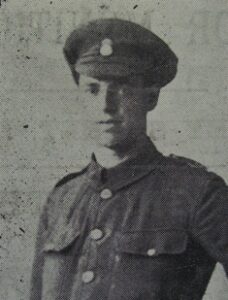
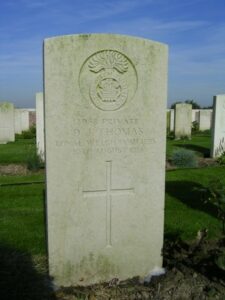
Gwilym Thomas, Private, 12910, Welsh Regiment. Gwilym was the son of John and Mary Ann Thomas, of Hebron House, Cross Hands. He enlisted at Tumble into the 1st Battalion, Welsh Regiment, which was in France attached to 84 Brigade, 28th Division. The Division formed in England between December 1914 and January 1915 from regular units returning from India, Singapore and Egypt. During January 1915 it moved to France, landing at Le Havre and moved to the Western Front, where it saw its first major action during the Second Battle of Ypres. The Division then took part in the Battle of Loos, and it was here that Gwilym was wounded, dying as a result on 12 October 1915. He was 17 years old, and is buried at Les Gonards Cemetery, Versailles, France.
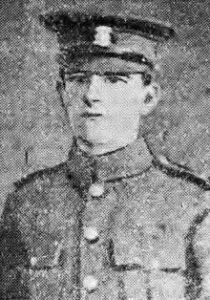
John Thomas, MM, Driver, W2943, Royal Field Artillery. John was the son of Mary Ann Jones, of 13, High Street, Tumble. He enlisted at Ammanford into the Royal Field Artillery, and joined the 38th Trench Mortar Battery, which was attached to 38th (Welsh) Division. The Division had landed in France during December 1915 and had spent their first winter in the trenches near Armentieres. In June they marched south to the Somme, where they were tasked with the capture of Mametz Wood. The attack on the wood began on 7 July, but met with fierce resistance, and it took until 14 July to totally clear the wood. The Division suffered terrible casualties at Mametz, and were taken out of the line, and moved to Ypres to rebuild. Here they fought at the Battle of Pilckem Ridge, and the Battle of Langemarck. They then moved to Armentieres, where they remained from September 1917 until March, 1918 when the German Spring Offensive was launched. John was killed in action during the German assault on the Lys on 30 March 1918. He was 22 years old, and is buried at Merville Communal Cemetery Extension, France.
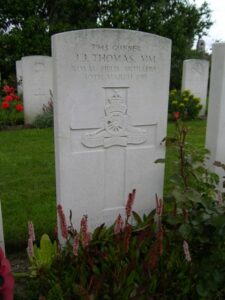
John Thomas, Private, Welsh Regiment. John cannot presently be identified.
John James Thomas, Private, 438, East Surrey Regiment. John was born at Camberwell in 1887, the son of John and Emma Thomas. Prior to the war he had married Annie Evans, at Bethel Chapel, Tumble, and he resided with her at her family home at 65, High Street, Tumble, where he worked as a coal hewer. John enlisted there into the East Surrey Regiment on 31 August 1914. On 28 May 1915 John landed in France with the 7th Battalion, East Surrey Regiment, which was attached to 37 Brigade, 12th (Eastern) Division, which moved into the line at Ploegsteert Wood. On 12 June 1915 Annie gave birth to the couples’ son, David John Thomas, but sadly the young boy took ill, and died in October that year. John’s division was by then at Loos, and was in the midst of heavy fighting around the Hohenzollern Redoubt, however John had damaged his knee a week prior to his sons’ death, and was already on his way home for hospital treatment. After recuperating, and returning home to attempt to console his bereaved wife, John was sent back to France on 23 February 1916, rejoining his battalion at Loos. John had only been back at the front for four weeks, when he was killed in action on 19 March 1916. He was 28 years old, and is buried in Chocques Military Cemetery, France.
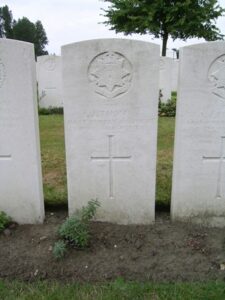
Joseph Stanley Thomas, Private, 57515, Royal Welsh Fusiliers. Joseph was the son of David and Hannah Thomas, of Mount Pleasant, Tumble. He had originally enlisted into the 4th Welsh, but was later transferred into the 9th Battalion, Royal Welsh Fusiliers, which was attached to 58 Brigade, 19th (Western) Division. He would have taken part in some hard fighting with the division during his time at war, but at some time was diagnosed as suffering from tuberculosis and returned home. He died of tuberculosis on 1 April 1921, aged 22. Joseph is not named on the Tumble War Memorial, and is not commemorated by the CWGC.
Zachariah Thomas, Private, 1377, Welsh Regiment. Zachariah was the son of John and Anne Thomas, of Pwllybwmper, Penypark, Cardigan. He worked as a miner prior to the war, and lived at 22, High Street, Tumble. He enlisted at Pontypridd into the 2nd Battalion, Welsh Regiment, which was attached to 3 Brigade, 1st Division, and landed in France on 21 September 1914.He joined the battalion in time to take part in its epic defence of the Menin Road, during the First Battle of Ypres, and was wounded in the head. The division then moved to the Neuve-Chapelle sector, and the following year suffered heavy casualties during the Second Battle of Ypres. Zachariah had recovered from his wounds by now and rejoined the battalion. During the summer of 1915 the Division moved into position at Loos, and took part in the Battle of Loos, which was launched on 25 September 1915. Zachariah was killed in action at Loos on 26 September 1915, aged 26, and is commemorated on the Loos Memorial, France. He is not commemorated at Tumble.
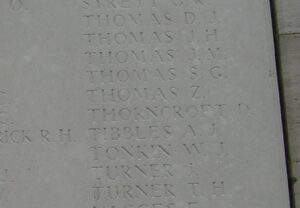
Bertram Treharne, Leading Seaman, Z/744, Royal Navy. Bertram was born at Tumble on 26 March 1893, the son of William Treharne. William then took up ownership of the Prince Albert Vaults at Pembroke Dock, and moved his family there to live. Bertram enlisted on 10 April 1915 into the Royal Navy, and on 16 August 1915 was posted for duty with the Grand Fleet. Bertram was posted aboard the battlecruiser HMS Indefatigable, which served in the 1st Battlecruiser Squadron of the Grand Fleet. She sadly became the first casualty of the Battle of Jutland on 31 May 1916. Indefatigable was struck by a salvo of shells from the German battlecruiser SMS Von der Tann, which exploded her magazines, sending her to the bottom in minutes, with the loss of all bar three of her crew of 1,017. Bertram was one of the dead, and is commemorated on the Plymouth Naval Memorial, Devon.
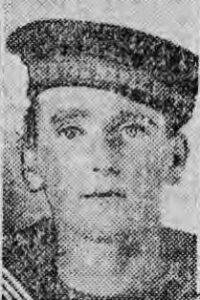
James Wadsworth, Lance Corporal, 11300, Yorkshire Light Infantry. James was born at Leeds on 19 March 1896, the son of Henry and Kate Elizabeth Wadsworth. He resided at Tumble prior to the war, and enlisted there into the Yorkshire Light Infantry. James served in France from 21 May 1915 with one of the regular battalions, and at some time was transferred to the 2/5th Battalion, Yorkshire Light Infantry. The battalion was attached to 187 Brigade, 62nd (2nd West Riding) Division, and concentrated on the Western Front by 18 January 1917, where it took part in Operations on the Ancre. In March 1917 the Division followed the German Retreat to the Hindenburg Line, and then fought at the Battle of Arras, during the Flanking Operations Round Bullecourt. James was killed at Bullecourt on 3 May 1917. He was 21 years old, and is commemorated on the Arras Memorial, France.
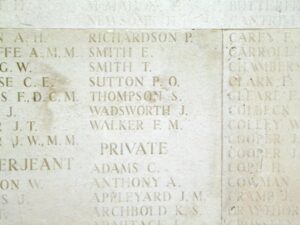
Henry Watkins, Private, 2283, Welsh Regiment. Henry was born in 1888, and resided at Brynyfedw Stores, Upper Tumble, where he worked as a haulier. He enlisted at Tumble on 11 January 1915 into the Welsh Field Artillery, which was attached to the 38th (Welsh) Division. Henry was discharged as medically unfit on 24 February 1915, and on 28 June 1915 re-enlisted, joining the 3/4th Battalion, Welsh Regiment, a reserve battalion which remained on home service throughout the war. Henry remained on home service until being discharged as medically unfit on 10 December 1916. He was not physically fit for further service, as he had suffered injuries to his feet during an accident at Tumble in 1912, which required him to have several toes amputated. Henry died at Tumble in the summer of 1918, aged 30. He was not eligible for commemoration by the CWGC, due to his ill health not being caused by his military service.
Frank Williams, Gunner, 98096, Royal Field Artillery. Frank was born at Kingston, Somerset in 1891. He had worked at Llanelli in one of the Tinplate Works prior to 1911, but had been hurt in an accident, and moved to Tumble prior to the war. Frank enlisted there into the Royal Field Artillery, and was posted to B Battery, 47th Brigade, Royal Field Artillery, which was attached to the 14th (Light) Division. The Division was to see its first action during the Action of Hooge, where it became the first unit to be attacked by the German use of flamethrowers. They then fought at the Second attack on Bellewaarde. In July, 1916 they moved to the Somme, and fought at the Battle of Delville Wood, and then the Battle of Flers-Courcelette, and in March, 1917 followed the German Retreat to the Hindenburg Line. May saw them at Arras, where they took part in the First Battle of the Scarpe, and later at the Third Battle of the Scarpe, and then they were sent to Ypres, where they fought at the Battle of Langemarck, the First Battle of Passchendaele and the Second Battle of Passchendaele. In the Spring of 1918 the Division were near St. Quentin, and were hit there by the German Spring Offensive, launched on 21 March. Frank was killed during that terrible first day of the offensive on 21 March 1918. He has no known grave, and is commemorated on the Pozières Memorial, France.
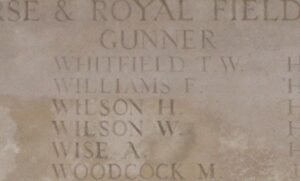
Idris John Williams, Private, 13924, Royal Welsh Fusiliers. Idris was born at Ffynonwen, Login, near Whitland on 6 December 1897, the son of David and Mary Ann Williams. After Idris had been educated at Whitland County School, the family moved to Rock House, Tumble, where Idris took up work as a miner. He enlisted at Tumble into the Army on 5 September 1914, and was posted to the 11th Battalion, Royal Welsh Fusiliers, which was attached to 67 Brigade, 22nd Division. The Division crossed to France in early September 1915, but on 27 October 1915 the Division, having been moved by train to Marseilles, began to embark for Salonika, taking part in the Retreat from Serbia during December 1915. Idris took ill and died of typhoid on 29 March 1916. He was 19 years old, and is buried in Salonika (Lembet Road) Military Cemetery, Greece.
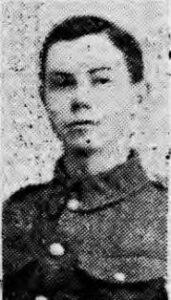
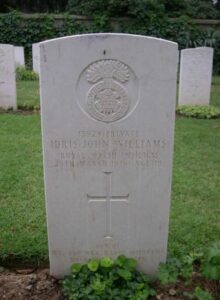
World War Two, 1939-1945
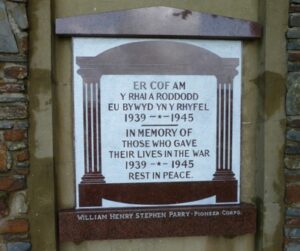
Idris Llewellyn Davies, Ordinary Seaman, Merchant Navy. Idris was the son of David and Doris Davies, of Tumble. He served with the Merchant Navy aboard the S.S. Thornlea, a Newcastle on Tyne registered cargo steamer. On 2 September 1940, Thornlea was 200 miles off Ireland, on route from Swansea for Montreal with a cargo of coal, when she was torpedoed and sunk by the German submarine U-46, with the loss of three lives. Idris was just 16 years old when he died that day, and is commemorated on the Tower Hill Memorial, London. Idris is not named on the Tumble Memorial.
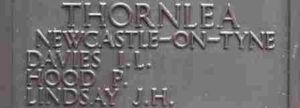
Ivor Bowen Davies, Sergeant, 1338056, Royal Air Force Volunteer Reserve. Ivor was the son of Thomas Gibbon Davies and Jane Davies, of Upper Tumble. He served with the Royal Air Force, and was based in South Africa. Ivor died in South Africa on 12 December 1942, aged 20, and is buried at Grahamstown New Cemetery, South Africa. Ivor is not named on the Tumble Memorial.
Russell Fokes, Rifleman, 5338931, Rifle Brigade. Russell was the son of Stanley T. and Florence Fokes, of Trimsaran. He served with the 1st Battalion, Rifle Brigade. The battalion had originally been wiped out during the defence of Calais in May 1940, and reformed before sailing for North Africa with the 1st Armoured Division. It later served with 22nd Armoured Brigade, 7th Armoured Division during the Battle of El Alamein, and returned to Britain when the division was recalled to train for the forthcoming Normandy landings. Russell was killed in action in Normandy on 29 July 1944, aged 26. He is buried in Ranville War Cemetery, France.
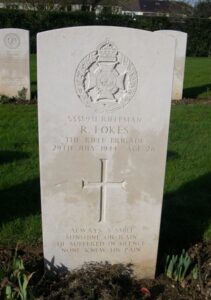
William Henry Harry, Private, 7605441, Cheshire Regiment. William was the son of David Harry and Jane Harry, of Tumble. He served with the 8th (HD) Battalion, Cheshire Regiment, which was a Home Defence unit. William died on active service on 28 November 1941, aged 40, and is buried at Tumble (Bethania) Congregational Chapelyard. William is not named on the Tumble Memorial.
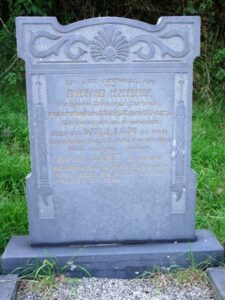
Eugene Glyndwr Jones, Signalman, D/JX 232974, Royal Navy. Eugene was the son of Henry James Jones and Gwendoline Bridget Jones, of Tumble. He served with the Royal Navy aboard H.M. Trawler Laertes, a trawler that had been requisitioned by the Admiralty for minesweeping duties. On 25 July 1942 Laertes was working off the coast of Guinea when she was torpedoed and sunk by the German submarine U-201, with the loss of 19 lives. Eugene was 19 years old when he died, and is commemorated on the Plymouth Naval Memorial, Devon. Eugene is not named on the Tumble Memorial.
William Henry Stephen Parry, Private, 13115994, Pioneer Corps. William was the son of Thomas and Sarah Jane Parry, of Upper Tumble. He served with the Pioneer Corps in the North African campaign. After the capitulation of the Axis forces in North Africa in 1943, the Allies turned their attention to Sicily and mainland Italy. William was killed in Italy on 20 July 1943. He was 26 years old, and is buried at Syracuse War Cemetery, Sicily.
Leonard Rees, Sergeant (Air Gunner), 1316649, Royal Air Force Volunteer Reserve. Leonard was the son of Sydney and Elizabeth Jane Rees, of Tumble. He served with 102 Squadron, Royal Air Force, which was equipped with the Handley Page Halifax II, based at RAF Pocklington. Leonard was killed when his Halifax was brought down over Belgium on 28 August 1943. He was 23 years old, and is buried at Heverlee War Cemetery, Belgium. Leonard is not named on the Tumble Memorial.
Martyn Luther Rees, Able Seaman, D/JX 350214, Royal Navy. Martyn was the son of Gwyn Thomas Rees and Edlina Rees, of Tumble. He served with the Royal Navy aboard H.M.S. Mahratta, an M-Class destroyer. On 25 February 1944, Mahratta was off the coast of Norway when she was torpedoed and sunk by the German submarine U-990, with the loss of 220 lives. Martyn was 22 years old when he died that day, and is commemorated on the Plymouth Naval Memorial, Devon. Martyn is not named on the Tumble Memorial.
Sergeant Michael James Winkler, Royal Corps of Signals
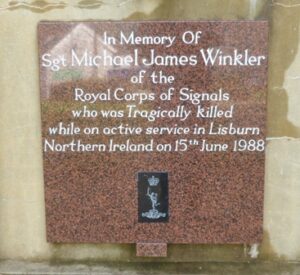
Michael James Winkler, Sergeant, 24310380, Royal Corps of Signals. Michael was born on 17 March 1957. He was serving with the Royal Corps of Signals in Northern Ireland during the height of the troubles. On 15 June 1988, Michael, along with a group of other servicemen, were off duty, and had just completed a charity run for local charities in Northern Ireland. Michael, along with five other servicemen, boarded their minibus, which had been parked in the Market Square, Lisburn, County Antrim, when it exploded, killing all six of the men. The minibus had been targeted by the IRA, who had placed a bomb in it. The action of the IRA was rightly condemned, as the men targeted had given up some rare time off to raise money for local charities, and were all off duty. Michael was 31 years old. The other soldiers who died in the explosion were; Corporal Ian Metcalf, 1st Bn The Green Howards, aged 36; Lance Corporal Graham P. Lambie, Royal Corps of Signals, aged 22; Signalman Mark Clavey, Royal Corps of Signals, aged 24; Corporal William J. Paterson, Royal Corps of Signals, aged 22, and Lance Corporal Derek W. Green, Royal Army Ordnance Corps, aged 20. Michael’s body was brought home, and he was buried at Llannon Cemetery.
Gwendraeth Valley Colliers Memorial
